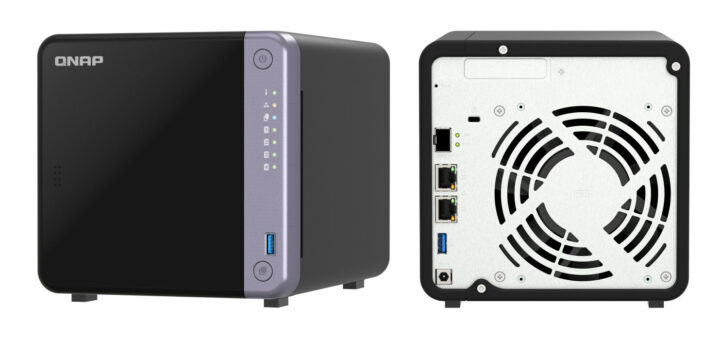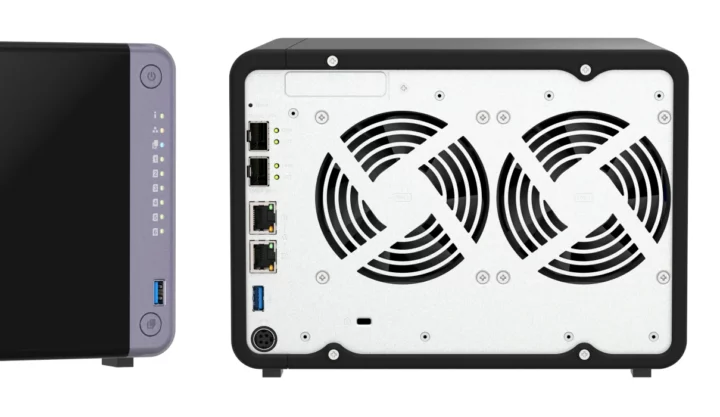QNAP has unveiled TS-432X 4-bay and TS-632X 6-bay Tower NAS systems that feature not only 2.5GbE ports but also one or two 10GbE SFP+ cages, as well as one PCIe Gen 3 x4 slot and are powered by an Annapurna Labs Alpine AL524 4-core 64-bit Arm processor.
We had seen NAS with 10GbE networking before such as the QNAP HS-453DX and ASUSTOR FLASHSTOR, but those were powered by Intel processors. The new TS-432X and TS-632X NAS systems combine a 64-bit Arm processor and 10GbE networking in a way similar to the earlier QNAP TS-431X-2G-USARM powered by a dual-core 32-bit Arm CPU.

QNAP TS-432X/TS-632X specifications:
- SoC – Annapurna Labs Alpine AL524 4-core 64-bit Arm processor @ up to 2.0 GHz
- System Memory – 4GB DDR4 (non-ECC), upgradeable up to 16GB DDR4 (ECC memory supported) via SO-DIMM socket
- Storage
- 512 MB flash with dual boot OS protection
- Drive bays
- TS-432X – 4x 3.5-inch SATA 6Gb/s, 3Gb/s; supports JBOD, Single, RAID 0, 1, 5, 6, 10
- TS-632X – 6x 3.5-inch SATA 6Gb/s, 3Gb/s; supports JBOD, Single, RAID 0, 1, 5, 6, 10, 50
- Compatible with 3.5-inch SATA HDD, 2.5-inch SATA HDD and SSD
- Hot-swappable
- SSD cache acceleration support
- Networking
- 2x 2.5GbE RJ45 ports
- TS-432X – 1x 10GbE SFP+ cage
- TS-632X – 2x 10GbE SFP+ cages
- Wake on LAN (WOL) and Jumbo Frame support
- USB – 2x USB 3.2 Gen 1 ports
- Expansion – PCIe Gen 3 x4 slot for cards up to 190 x 68.9 x 18.76 mm
- Misc
- LED Indicators – Power, Status, LAN, USB, HDD LEDs
- Buttons – Power, Reset, USB Auto Copy
- 1x (TS-432X) or 2x (TS-632X) 90mm 12VDC fans
- Buzzer
- Kensington Security Slot
- Power Supply
- TS-432X – 12V DC (90W)
- TS-632X – 12V DC (120W)
- Dimensions and Weight
- TS-432X – 226.5 × 170 × 165 mm | 1.99 kg
- TS-632X – 226.5 × 235 × 165 mm | 2.5 kg
- Temperature Range – Operating: 0 – +40°C; storage: -20 to +70°C
- Relative Humidity – 5-95% RH non-condensing, wet bulb: 27
The TS-432X and TS-632X run QTS 5.1.7 Linux-based operating system with support for VPN and firewall security features, QVR Surveillance Solution to transform the NAS into a video surveillance system, Container Station for Docker applications, an App Center to install various applications, and more.
The press release says the new 64-bit Arm NAS are cost-effective entry-level business NAS models”, but I was unable to find any price information, and the TS-432X and TS-632X are yet to be listed on QNAP’s Amazon store. More information may be found on the product pages for the 4-bay and 6-bay NAS.
Thanks to TLS for the tip.

Jean-Luc started CNX Software in 2010 as a part-time endeavor, before quitting his job as a software engineering manager, and starting to write daily news, and reviews full time later in 2011.
Support CNX Software! Donate via cryptocurrencies, become a Patron on Patreon, or purchase goods on Amazon or Aliexpress






The specs look pretty decent. At least they understood that customers don’t want to be constrained to very little DRAM, and with the upgradability option that’s perfect. However I’m surprised they still use AL524 because such chips are getting quite old (7-8 years) and I’m wondering how many there are left in stock. I would have guessed marvell chips instead, which are pretty good in that task, such as the CN913X family (a refreshed armada 8040 in fact).
Still? You sure you’re not confusing it with the AL514? The AL524 appears to be a new part, although I can’t find any specs for it.
Assume 4x A72 since the A7 and A15 seem to be 32-bit.
Still, if you want a modern cpu to run some local tasks you are probably better of with a rk3588 with 4x sata. Different customer target, different product.
Honestly, I/O-specific chips can be extremely good, and maybe this one is, I don’t know. RK3588 is more of a generic chip with quite a bit of horsepower but nothing exceptional on the I/O front beyond PCIe Gen3 x4. Other chips can bring accelerators, efficient controllers connected at the optimal place on internal busses, DMA offloaders that can perform some operations (crypto, xor etc) and lots of small stuff that can easily make a huge difference. I mentioned Marvel Armada 8K/CN9K but I could have suggested NXP’s Layerscape product range as well as extremely efficient chips for I/Os. I’m not surprised that such *type* of SoC is being used, I’m more surprised by this specific one given that I suspect that many years after Anapurna Labs was sold to AWS, they’re not producing any chips anymore, and stocks might be melting like ice in the sun. But that could also be a trick to get a cheaper device.
I do believe the 524 is better than an rpi4, but still there is a whole gap between rpi4 and rk3588. I doubt the 524 is better than the rk3588. And never forget the price impact.
There is probably no need to make the product more power efficiënt as an A72 since it will be used with just a bunch of hard drives.
Again I’m not dismissing the RK3588, it’s just a modern generic chip. I managed to make it reach 26 Gbps of HTTP traffic and serve 10 Gbps of NFS from SATA to a 10GE NIC (on the Rock 5 ITX). So it’s definitely not bad at all. But it’s just not made for that task. There may be corner cases where it will suffer (e.g under an interrupt storm). For example an old Armada 8040 has no problem doing the same from SATA to 10GE without even touching PCIe, just using integrated parts that communicate very efficiently. And I’m not speaking about power efficiency, I don’t care much, I’m speaking about efficiency in terms of the level of performance you get from such limited cores. There are even a few 10G routers based on A53s, just because it’s the hardware around that does the job while they’re mostly twidling thumbs. On Armada for example, integrated controllers can deposit data directly into the L2 cache so you’re not even constrained by the DRAM bandwidth if you evacuate the data fast enough. sendfile() is ultra-cheap on such devices, while a more generic one using PCIe may not necessarily have that luxury.
Given that Annapurna Labs have been acquired in 2015 by Amazon to develop their Gravitron series of datacenter CPUs, I would be surprised if there were any new CPUs from them.
Here is a datasheet for a Buffalo tech NAS using the AL524. It is copyrighted 2017.
buffalotech.com/images/uploads/TS5020_Datasheet_V7.3.pdf
Right, that was the only other company I could find that was using that SoC, but I couldn’t figure out when they release that NAS initially. There’s almost no data anywhere about the AL524 though, which is kind of bizarre.
That said, copyright doesn’t mean a document was produced that year and in fact, the TeraStation 5020 series was only launched in early 2023.
https://www.buffalotech.com/news/buffalo-launches-new-terastation-5020-family-of-high-performance-nas
Also, if you read the QNAP press release, it mentions “AnnapurnaLabs, an Amazon company Alpine AL524 quad-core 2.00 GHz processor”.
Maybe they’ve kept some important customers after their acquisition and are still able to sell a SoCs to a few of them. We can imagine that it could have been some of the conditions AL put on the deal with Amazon, that’s something that commonly happens.
I guess AL524 should be based on Cortex-A57.
I had tried to understand how Annapurna Labs’ part number is defined before. Of course it’s not written in a official dcoument though:
AL … prefix
2/3/5/7 … Grade (like Core i3/i5/i7). e.g. AL212 was dual Cortex-A15 1.4 GHz, AL314 was quad Cortex-A15 1.4 GHz, AL514 was quad Cortex-A15 1.7 GHz. Graviton 1 was AL73400
1/2/3 … Generatiom, like Alpine v1/v2/v3 platform. Alpine v1 (Cortex-A15) was AL-x1x, Alpine v2 (Cortex-A57) was AL-x2x, Alpine v3 (Cortex-A72) was AL-x3x
e.g. Graviton AL73400 was Alpine v3 platform
https://lore.kernel.org/linux-arm-kernel/10a6ff94-98fc-e88f-64c0-5648586613db@amazon.com/t/
Alpine v1 device tree
https://github.com/torvalds/linux/blob/master/arch/arm/boot/dts/amazon/alpine.dtsi
Alpine v2 device tree
https://github.com/torvalds/linux/blob/master/arch/arm64/boot/dts/amazon/alpine-v2.dtsi
Alpine v3 device tree
https://github.com/torvalds/linux/blob/master/arch/arm64/boot/dts/amazon/alpine-v3.dtsi
00 … Optional suffix. It seems like consumer products are 3 digits (e.g. AL514) and enterprise products are 5 digits (e.g. AL51400)
Please try https://techinfodepot.shoutwiki.com/wiki/Annapurna_Labs
Actually, they used Cortex-A17 cores, which are an improved Cortex-A15. I guess they looks the same to the OS though, but they’re not identical.
A Cortex-A57 in say 2022 (a year before the Buffalo NAS launch) would’ve been a really odd choice, but hopefully I will know in a few weeks time, as I’ve requested a review sample for a different publication that I do some content for.
Would be great if you could submit /proc/cpuinfo then over at https://github.com/ThomasKaiser/sbc-bench/issues
Will do, but I can already confirm it really still is a Cortex-A57 design, so it will most likely not have particularly great performance.
For compensation it will have a great power consumption 🙂
Beware the huge amount of data qnap devices send home. If you block this at the firewall, after seeing data being sent as you access files and services, the interface goes grey and whines like a child, you loose functionality too. I used to like them, but no longer.
Interestingly a couple of local shops already list compatible RAM modules for this device…